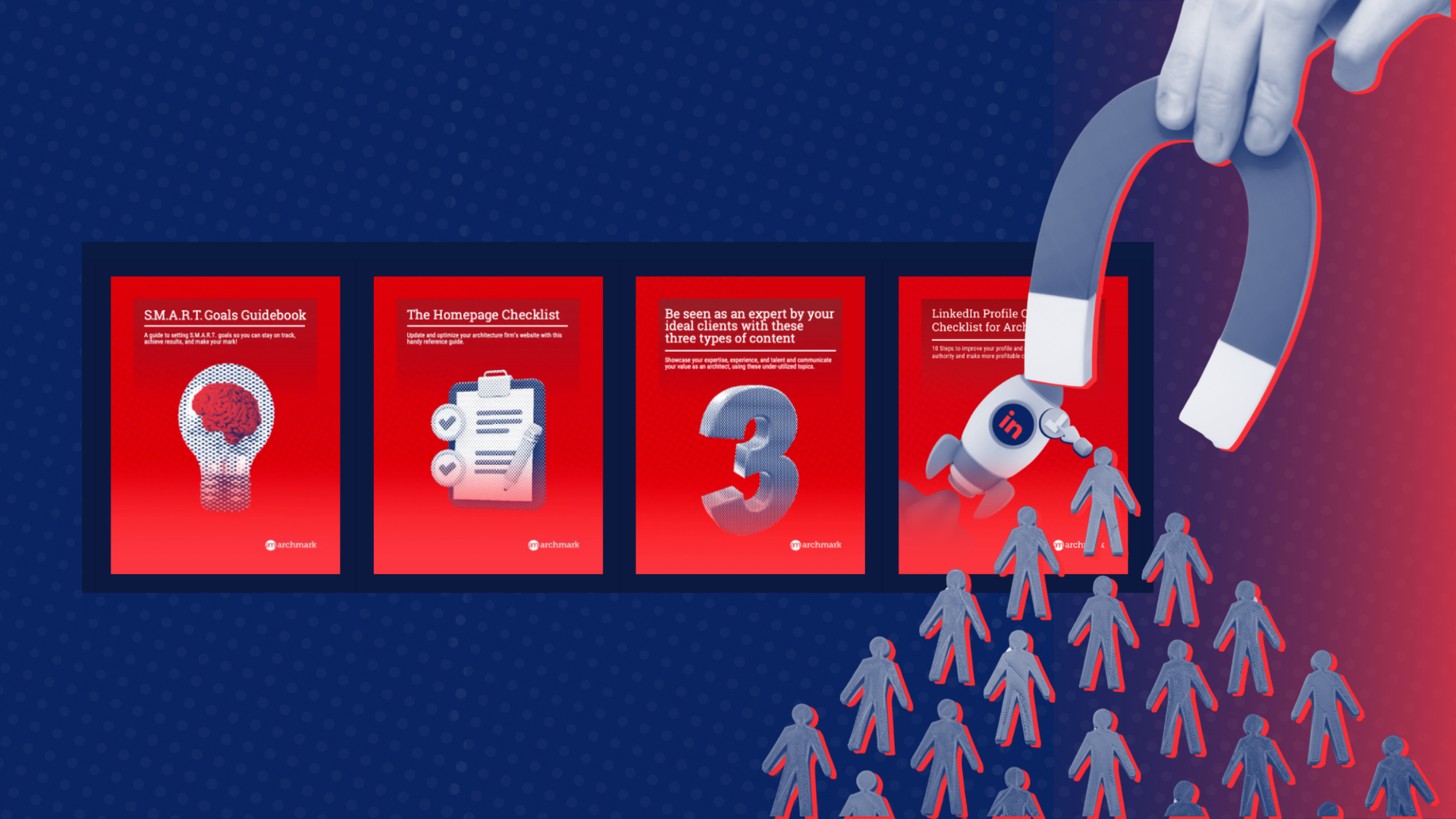Rethinking Brand Identity for Architecture Firms: Your Story Matters More Than Your Logo
In the world of architecture, branding often gets boiled down to one thing: the logo.
Many architects invest too many hours and resources into designing the "perfect" logo, believing it to be the cornerstone of their brand.
However, this approach misses the mark.
While a logo is a key visual element, it’s not the most important aspect of your brand. In fact, focusing too much on your logo can distract you from what truly matters: Your firm’s story, messaging, and the unique value you bring to your clients.
This article explores why a strong brand identity goes far beyond a logo and delves into the essential components that make up a powerful brand for your architectural firm.
By understanding the importance of your brand’s purpose and narrative, you’ll be better equipped to create a brand that resonates with your ideal clients and sets your firm apart in a meaningful and memorable way.
The Value of a Strong Brand Identity in Architecture
A strong brand identity is crucial for standing out in the competitive field of architecture. It’s not just about recognition—it’s about conveying the value and uniqueness of your architecture services in a way that resonates with clients.
When your brand identity is clear and well-articulated, it serves as a powerful tool for differentiation. It helps potential clients quickly understand what your firm stands for and why they should choose you over others. A strong brand identity also builds credibility, making it easier for clients to trust your expertise.
Clients are more likely to remember and choose a firm with a strong, consistent brand identity. This identity acts as a promise of quality, signaling that your architecture firm is professional, reliable, and aligned with their needs.
In fact, 59% of consumers prefer to buy from brands they trust, and a strong, consistent brand identity plays a significant role in building that trust.
Over time, a consistent brand identity can foster client loyalty and positive word-of-mouth.
Consider firms like Zaha Hadid Architects or Gensler, which have established strong brand identities that are recognized worldwide. Their brand identities are not just about logos; they encompass their design philosophy, client approach, and the impact they aim to create through their work.

Brand Identity Is More Than Just a Logo
It’s a common misconception in the architecture industry that a brand is synonymous with a logo. While a logo is an important symbol, it’s just one piece of the branding puzzle.
Focusing too much on your logo and the visual elements can lead you to overlook the deeper aspects of branding that truly define your firm.
The truth is, a logo alone doesn’t create a brand; it’s the story behind the logo that matters.
"A logo doesn’t do anything on its own. It’s just a design. How does your logo signal to people that you provide quality, that you stand for something? That’s what a logo should do—it should signal to people that this is a quality firm, this is someone they want to work with."
- Bryon McCartney, Co-Founder & Chief Strategist at Archmark
When too much attention is placed on creating a visually appealing logo, other critical elements of brand identity—like your firm’s mission, vision, and values—can be neglected. This narrow focus can result in a brand that looks good on the surface but lacks depth and fails to resonate with clients.
Brand identity encompasses everything that represents your firm, from the tone of your messaging to the look and feel of your communications.
It’s about creating a cohesive and consistent experience for your clients that reflects who you are as a firm. When all elements of your brand identity are aligned, they work together to build trust and recognition.
The Core Components of an Effective Brand Identity
A brand identity is made up of several components, each contributing to the overall impression your firm makes on clients.
Understanding these components is key to building a cohesive and effective brand.
Your brand identity includes visual elements like your:
- logo
- color palette
- typography
And, it must also include your firm’s:
- tone of voice
- messaging
- overall experience you provide for clients, collaborators, and team members
Each component should align with your firm’s values and the story you want to tell.
When all elements of your brand identity work together harmoniously, they create a unified image that is instantly recognizable and memorable. This cohesion not only enhances your brand’s professionalism but also helps build trust with clients.
Your Brand’s Story and Messaging Matter Most
While a logo might catch the eye, it’s your brand’s story and messaging that truly connect with clients on a deeper level. These elements are what give your brand meaning and make it memorable.
“Having a strong visual brand is actually not nearly as important as having a strong brand in terms of knowing what your purpose is, why you do what you do, and knowing what makes you different from another firm. Those are remarkably more important than having a logo.”
- Bryon McCartney, Co-Founder & Chief Strategist at Archmark
A compelling brand story can set your firm apart by highlighting what makes you unique. It’s an opportunity to share your values, mission, and the journey that has shaped your firm.
A well-crafted story resonates with clients, making them more likely to choose your firm over others. 73% of consumers are willing to pay more for a product if they love the brand behind it .
Start by identifying the key elements of your firm’s journey—your founding, your vision, the challenges you’ve overcome, and your most significant achievements. Use these elements to create a narrative that is both authentic and inspiring.
Your story should be woven into all aspects of your branding, from your website to your client communications.
Clear, consistent messaging helps reinforce your brand’s identity and ensures that clients understand what you stand for. Whether it’s through your website copy, social media posts, or client interactions, your messaging should always align with your brand’s values and purpose, reinforcing your firm’s reputation for quality and integrity.
Build a Visual Identity That Complements Your Brand Story
Your visual identity should work in harmony with your brand story, reinforcing the messages you want to convey and creating a cohesive experience for your clients.
Your visual identity is the visual manifestation of your brand story. It includes your logo, color palette, typography, and any other design elements that represent your firm. These elements should be carefully chosen to complement and enhance your brand narrative, helping to communicate your story visually.
Start by selecting visual elements that align with your brand’s values and message. Your color palette should evoke the emotions you want clients to feel, and your typography should match the tone of your brand. By creating a cohesive visual identity, you ensure that all client touchpoints—from your website to your business cards—reflect a unified brand image.
When choosing colors, consider the psychological impact they have. For example, blue can convey trust and professionalism, while green might suggest sustainability. Select fonts that are easy to read and reflect your brand’s personality—whether that’s modern and sleek or classic and refined. Ensure that all design elements work together to create a visual identity that supports and enhances your brand story.

Align Your Brand Story With Your Firm’s Values
For your brand story to be effective, it must be deeply aligned with your firm’s core values. This alignment ensures that your brand is not only authentic but also resonates with the right clients.
Your brand story should be a reflection of your firm’s purpose—the reason you exist and the impact you aim to make. It should also align with your long-term vision, providing clients with a sense of where you’re headed and what you stand for. This alignment builds credibility and fosters trust.
To ensure your values are consistently communicated, incorporate them into all aspects of your branding. This might mean highlighting your commitment to sustainability in your project descriptions or emphasizing your client-first approach in your communications. Consistent messaging helps clients understand and connect with your values.
When your brand is built on clear, authentic values, it naturally attracts clients who share those values. This alignment leads to stronger client relationships, as both parties are working toward a common goal. A value-driven brand also sets the stage for long-term success, as it fosters loyalty and encourages repeat business.
BONUS:
Consistent brand presentation across all platforms
can increase revenue by up to 23%.
Consistency is Key: Integrate Your Brand Across All Client Touchpoints
A strong brand identity must be consistently applied across all platforms and client touchpoints to be truly effective.
Consistency is key to building a strong brand. Make sure that your logo, color palette, and typography are used consistently across all materials, including your website, business cards, social media profiles, and signage. Make sure the messaging and client experience is also consistent.
This consistent application helps reinforce your brand identity and makes it easier for clients to recognize and remember your firm.
Whether a client is visiting your website, receiving an email from you, or meeting with you in person, they should have the same experience of your brand. A unified brand presence across all platforms ensures that your messaging is consistent and that your brand identity is clear and cohesive.
To maintain brand coherence, create a set of brand guidelines that outline how your brand elements should be used. This includes rules for logo placement, color usage, and typography, as well as guidelines for tone of voice and messaging.
By adhering to these guidelines, you can ensure that your brand remains consistent and recognizable in every client interaction.
For more tips on creating a strong marketing strategy, check out our post on
Maximizing Marketing ROI for Architecture Firms.

Your Brand is More Than Just a Logo—It’s the Heart of Your Architecture Firm
In this blog, you’ve learned that a strong brand identity is about more than just a logo; it’s about telling your firm’s unique story, delivering consistent messaging, and aligning with your core values.
“As an architect, you’re not going to be known for your logo. You’re going to be known for the services you provide, the way you provide those services, and the care you take in helping your clients realize their dreams. Those are the things you want to be remembered for.”
- Bryon McCartney, Co-Founder & Chief Strategist at Archmark
With this knowledge, you can now craft a brand that resonates deeply with clients, builds trust, and differentiates your firm in a meaningful way.
If you’re ready to take your architecture firm’s brand to the next level, Archmark is here to help.
Contact us today to learn how we can support you in building a brand that truly reflects the heart of your firm.












